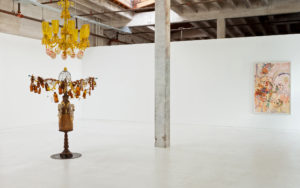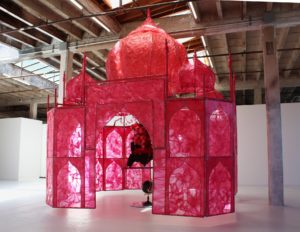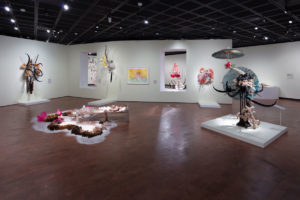Walking into one of Rina Banerjee’s art installations is like entering a colourful, surreal  Xanadu—one where contemplation and self-introspection wait around every corner.
Xanadu—one where contemplation and self-introspection wait around every corner.
Banerjee was born in Kolkata but is a long-time New Yorker. Her assemblages of globally sourced objects and materials, along with her drawings and paintings, bring together disparate elements from world cultures and invite discourse.
“I am terribly interested in our socialisation toward culture and community, and perhaps this is where diaspora becomes an entry point to which we can converse on identity politics, national boundaries, immigration, poverty, social justice and gender inequality,” she says.
But Banerjee does not intentionally go out to make a statement with her work. “I am convinced I don’t know myself nor understand anything when I start, and this agitation propels my grasp at knowing,” she says, adding the moment is volatile and enjoyable at the same time. “I feel connected with myself and this is what makes me feel connected with the desire to be with the world, feel its earnest presence, its slippery tension.”
One of her sculptures evokes an ethereal Taj Mahal but is made of layers of rose-red plastic cling wrap, conveying a sense of exoticism as well as consumerism. The 18-feet “building” is hung from the ceiling and invites visitors to walk into it. Its formidable materials list reads: “Plastic, antique Anglo-Indian Bombay dark wood chair, steel and copper framework, floral picks, foam balls, cowrie shells, quilting pins, coloured moss, antique stone globe, glass,  synthetic fabric, shells, fake birds.”
synthetic fabric, shells, fake birds.”
Banerjee’s first solo retrospective, a major travelling exhibition of her work, was called “Rina Banerjee: Make me a Summary of the World.” It was displayed at the Pennsylvania Academy of the Fine Arts in Philadelphia from 2018 to 2019. It travelled to other museums in California and Tennessee before its final display at the Nasher Museum of Art at Duke University in North Carolina until July 2021.
The exhibition unites dozens of Banerjee’s sculptures and works on paper, which bring together texts, subtexts and implications. Together with their long titles, the artworks make the viewer consider issues of culture, colonialism and feminism, among others.
“I find that my search to be present in my own life requires that a deep engagement is desirable and nourishing,” says Banerjee. “I would feel like I am starved if I could not make art reachable and knowable to myself and the world.”
After Banerjee’s family left Kolkata, she grew up in England before coming to Queens in New York City. She studied polymer engineering at Case Western University and worked in polymer chemistry before leaving science, receiving a Master of Fine Arts degree from Yale University and pursuing her art career in earnest. Last year, she began teaching as an art critic at Yale University.
 Banerjee’s creations have appeared around the world, including at the Smithsonian and at some of the world’s top shows like the Venice Biennale, Yokohama Triennale and the Kochi-Muziris Biennale. Her work is held in many collections, from the Whitney Museum of American Art and San Francisco Museum of Modern Art to the Pennsylvania Academy of the Fine Arts, San José Museum of Art, Kiran Nadar Museum of Art in New Delhi and the Brooklyn Museum in New York City.
Banerjee’s creations have appeared around the world, including at the Smithsonian and at some of the world’s top shows like the Venice Biennale, Yokohama Triennale and the Kochi-Muziris Biennale. Her work is held in many collections, from the Whitney Museum of American Art and San Francisco Museum of Modern Art to the Pennsylvania Academy of the Fine Arts, San José Museum of Art, Kiran Nadar Museum of Art in New Delhi and the Brooklyn Museum in New York City.
Banerjee rejects the notion that people choose to be artists. Rather, she says, “Let’s say that art is a reflex for artists and art seekers, and its boundless quality makes me work very hard and love it very much. I could also say that people never fail us; it’s our fixation on being fixed, rigid, standing in one place, that fails people, and this is where migration and ethnicity studies, postcolonialism and culture studies, queer studies keep us awake and moving as we are meant to.”
SPAN-TWF



